

A Jungle Myna, has been trained to go out and look for cash, then bring it back home with him. : interestingasfuck. Olfactory memory representations are stored in the anterior olfactory nucleus.
True & False Memories. Mem Model, Systems & General Explanations. Types of Learning & Neuroplasticity. Working memory. Long term memory. Angular Gyrus in Lrn & Mem. Pattern separation in the hippocampus. Amnesia. Dislodging Misinformation. Misinformation and Its Correction Continued Influence and Successful Debiasing. Misinformation and Its Correction were based on information from the stories, but reading thestories also increased people’s illusory belief of prior knowl-edge.
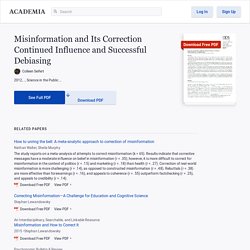
In other words, encountering misinformation in a fic-tional context led people to assume they had known it all alongand to integrate this misinformation with their prior knowl-edge (Marsh & Fazio, 2006; Marsh et al., 2003).The effects of fictional misinformation have been shown to be stable and difficult to eliminate. Marsh and Fazio (2006)reported that prior warnings were ineffective in reducing theacquisition of misinformation from fiction, and that acquisi-tion was only reduced (not eliminated) under conditions of active on-line monitoring—when participants were instructedto actively monitor the contents of what they were reading andto press a key every time they encountered a piece of misinfor-mation (see also Eslick, Fazio, & Marsh, 2011).
Few peoplewould be so alert and mindful when reading fiction for enjoy-ment. . Time. Module 5: Applications of Respondent Conditioning – Principles of Learning and Behavior. Module Overview Having covered basic and advanced topics in relation to respondent conditioning, also called classical or Pavlovian conditioning, I will now present some applications of the learning model in the real world.

To that end we will discuss the acquisition of fears (phobias) from a clinical psychology perspective, the paradigm of eyeblink conditioning, how food preferences and taste aversions are learned, PTSD and treatment approaches, and advertising and it use of the learning model. Module Outline 5.1. Fear Conditioning5.2. Module Learning Outcomes Describe how fears are learned and unlearned using respondent conditioning.Describe the use of the eyeblink conditioning procedure in respondent conditioning.Clarify how taste aversion occurs.Clarify how we acquire food preferences.Describe how respondent conditioning can be used to partially explain PTSD and to treat it.Propose ways to use respondent conditioning in advertising/marketing. 5.1. My boomer coworker said the most profound thing to me about how millennials learn and teach in a tech based world, and I am shook. : CasualConversation.
Neural Basis of Learning and Memory. Circuit Mechanisms of Sensorimotor Learning. Motor learning. Three Ways That Non-associative Knowledge May Affect Associative Learning Processes. Introduction Associative theories of learning offer a powerful account of the way animals and humans assess the relationship between events and generate expectations about the future.
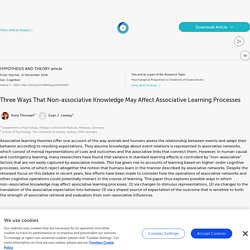
They assume that we reflect our knowledge about the predictive relationships between events in associative networks, which consist of mental representations of these events and the associations that link them. These events could be predictive cues and subsequent outcomes in the case of Pavlovian learning or actions associated with antecedents and consequences in the case of instrumental learning.
Through observing the co-occurrence of cues and outcomes, an individual learns the associations between them in such a way that the presence of a predictive cue brings to mind the outcome and thus informs subsequent behavior by generating an outcome expectation. Theories of associative learning in animals. Chapter 18 - Learning and Memory. Chapter 18 Let me begin by telling a little story.
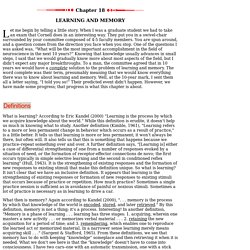
When I was a graduate student we had to take an exam that Cornell does in an interesting way. They put you in a swivel-chair surrounded by your committee composed of 4-5 faculty members. You are spun around, and a question comes from the direction you face when you stop. Neurobiology of Learning and Memory. Abstract Memory is fundamental to human life.

Qualitatively distinct types of memory enable us to change behavior in response to experience, to acquire and use a repository of knowledge, to recollect events from the past, and to plan for the future. In many respects, memory defines human individuality, as the memories of one person are necessarily different from those of another. Where they overlap, as in the shared memories of a community or a nation, they form a cultural memory that is often ritualized into various art forms. Distinguished Lecture Series on Brain, Learning and Memory - Center for the Neurobiology of Learning and Memory.
The Distinguished Lecture Series on Brain, Learning and Memory was founded in 1995 by James L.
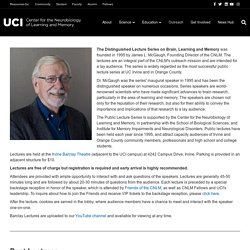
McGaugh, Founding Director of the CNLM. The lectures are an integral part of the CNLM's outreach mission and are intended for a lay audience. The series is widely regarded as the most successful public lecture series at UC Irvine and in Orange County. Dr. McGaugh was the series' inaugural speaker in 1995 and has been the distinguished speaker on numerous occasions. The Neuroscience of Learning & Memory: Part I. Hi, I’m David Handel, MD, retired radiologist and cofounder of iDoRecall.com.

I spent over 30 years as a practicing physician and radiologist, interpreting CT scans, MRIs and PET scans of the brain. I am totally blown away by the incredible advances we’ve made, particularly during the past 15 years, in gaining a deep understanding of how the brain creates memories and how we learn. In this series, we are going to review how our brain and mind functions, enabling us to learn, create and retrieve memories.
In Part I, we’ll lay the requisite groundwork you’ll need in order to understand what we know now in 2015. Feel free to skip ahead to Part II if you are already solidly grounded in the relevant basics of neuroscience. Just so we start on the same page, “What is neuroscience?” Neuroscience of Learning & memory. Learning and Memory - an overview. 5.0 A debate: is consciousness needed for episodic learning?

We learn about objects and scenes by paying attention to them. As mentioned in Chapter 8, the most obvious result of selective attention is that we tend to become conscious of the objects of attention, as we can prove by reporting our conscious experiences. Episodic memory is generally defined as memory for specific conscious episodes, like the sight of a coffee cup. However, we have also cited evidence that the hippocampal system can be stimulated by unconscious events, such as a subliminal picture of snakes or of emotional facial expressions. □ MyBib – A New FREE APA, Harvard, & MLA Citation Generator. Elemental and Configural Associative Learning in Spatial Tasks: Could Zebrafish be Used to Advance Our Knowledge? Introduction Spatial learning is a complex form of associative learning whereby the human or non-human animal learns and remembers the dynamic relationships among multiple environmental cues.
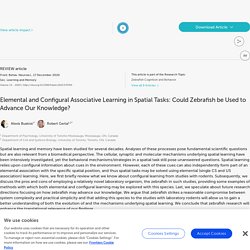
It requires perceiving and attending to multiple stimuli (the conditioned stimuli or CS’s), the acquisition of relational information about these stimuli and its association with the reinforcer (the unconditioned stimulus, or US), and the consolidation, maintenance, and recall of the relational memory (the memory of dynamic relationships among the spatial cues). We emphasize that the association between these environmental cues and the reinforcer includes establishing association among the cues, i.e., configural or relational information processing.
This type of learning may have high fitness value in rapidly changing, spatially complex, i.e., natural, environments. In this review, however, we focus on a relatively novel laboratory organism, the zebrafish. The Morris Water Maze. The Neuroscience of Learning, Memory, and Emotions. In the 1950s, a young man with permanent amnesia changed what we know about learning and memory.
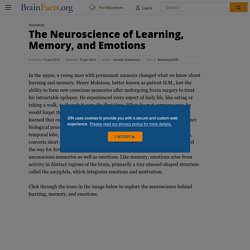
Henry Molaison, better known as patient H.M., lost the ability to form new conscious memories after undergoing brain surgery to treat his intractable epilepsy. He experienced every aspect of daily life, like eating or taking a walk, as though it were the first time. When he met someone new, he would forget the encounter within a few minutes. Implicit Learning and Memory: Psychological and Neural Aspects. Declarative Memory & Procedural Memory. Introduction Language is somehow dependent on two different systems of the brain.
Circuit Mechanisms of Sensorimotor Learning. Models of learning and memory at DuckDuckGo. Perceptual learning. Sensory modalities may include visual, auditory, tactile, olfactory, and taste. Perceptual learning forms important foundations of complex cognitive processes (i.e., language) and interacts with other kinds of learning to produce perceptual expertise.[1][2] Underlying perceptual learning are changes in the neural circuitry. The ability for perceptual learning is retained throughout life.[3] The Neuroanatomical, Neurophysiological and Psychological Basis of Memory: Current Models and Their Origins. Introduction A life full of unconnected events, of errors that do not lead to any lessons and of emotions without the ability to remember them is no life at all.
Memory is precisely the capacity that allows us to connect experiences, learn and make sense of our lives. In short, it allows us to build our story. The full range of this complex capacity’s neuroanatomical, neurobiological, neurophysiological, and psychological mechanism remain unknown and it presents a challenge for psychologists and neuroscientists who try to explain it. This review attempts to provide a rigorous overview that permits anyone who wants to approach the latest scientific findings on memory to do so, as well as to understand them and properly order them. The Neuroanatomical, Neurophysiological and Psychological Basis of Memory: Current Models and Their Origins.
This review aims to classify and clarify, from a neuroanatomical, neurophysiological, and psychological perspective, different memory models that are currently widespread in the literature as well as to describe their origins. We believe it is important to consider previous developments without which one cannot adequately understand the kinds of models that are now current in the scientific literature. This article intends to provide a comprehensive and rigorous overview for understanding and ordering the latest scientific advances related to this subject. Fear: Replacing Memories. January 04, 2010 The human brain goes through a complex process to form and consolidate memories.
But is it possible to replace memories of fearful events, and in doing so, assist in the treatment of patients suffering from the debilitating effects of post-traumatic stress disorder or other anxiety disorders? Dr.Joseph LeDoux and a team of New York University neuroscientists think they have found a way to replace traumatic memories through therapy. Download this video. Watch on YouTube. How repeated stress impairs memory. Anyone who has ever been subject to chronic stress knows that it can take a toll on emotions and the ability to think clearly. Now, new research uncovers a neural mechanism that directly links repeated stress with impaired memory.
The study, published by Cell Press in the March 8 issue of the journal Neuron, also provides critical insight into why stress responses can act as a trigger for many mental illnesses. The Neuroanatomical, Neurophysiological and Psychological Basis of Memory: Current Models and Their Origins. Implicit Memory – The Definitive Guide – Biology Dictionary. Definition.
Motor Learning - an overview. Brain's learning systems at DuckDuckGo. Learning: Meaning, Nature, Types and Theories of Learning. The neurobiology of pair bonding. Neuroscience and Learning: Implications for Teaching Practice. Animal learning - Types of learning. Holiday Lectures on Science. The neurobiology of learning and memory – as related in the memoirs of Eric R. Kandel - Surgical Neurology International. Author : Eric R. Kandel Published by : W.W. Norton & Co., New York, NY, USA. An alternative to the procedural∼declarative memory account of developmental language disorder. - Abstract. Introduction - Everything I know. Everything I Know. Yeah, I can add some points. (Fever dream material right here) This is very close to my heart. If you want to lift it wholesale (I doubt it), please give me credit. I would work on this as a fulltime startup, if I did not have visa restrictions and responsibilities :) 1.
Graphs as the fundamental way of navigating notes. 2. Emotional learning, stress, and development: An ever-changing landscape shaped by early-life experience. Learning and processing of navigational cues in the desert ant. Forgetting as the friend of learning: implications for teaching and self-regulated learning. The learning of fear extinction. Boundless Psychology. Learning and Memory - IResearchNet. Neuroscience Video Lectures. Being forgetful is a sign of high intelligence, according to scientists.
Younger generation fail to notice environmental decline due to generational amnesia. MTT Explained - Course NEUR 0193: Great Controversies in Neurobiology. Scientists create artificial link between unrelated memories. Deconstructing brain systems involved in memory and spatial skills. We don’t notice much of what we see: 85 college students tried to draw the Apple logo from memory; 84 failed. Discovering the Roots of Memory - Olga Khazan. Applied Cognition. MIT discovers the location of memories: Individual neurons. Fearful Memories Passed Down to Mouse Descendants.
Holiday Lectures on Science. Morris Water Maze Test for Learning and Memory Deficits in. Stress-Induced Impairment of a Working Memory Task: Role of Spiking Rate and Spiking History Predicted Discharge. Ben Thomas: How Stress Shatters Your Memory. Fearful Memories Passed Down to Mouse Descendants. Neuroscientists wipe specific memories, permanently. HOT ON THE TRAIL OF FLASHBULB MEMORY. Centre for Studies on Human Stress (CSHS) Is photographic memory real? If so, how does it work? Table of Contents — September 2012, 19 (9) Memory Disorders. Holiday Lectures on Science.